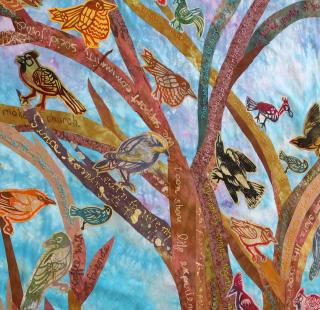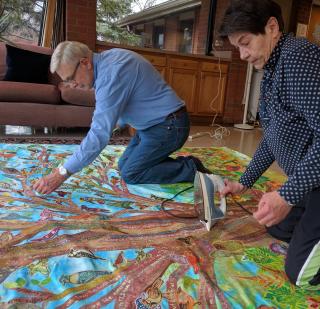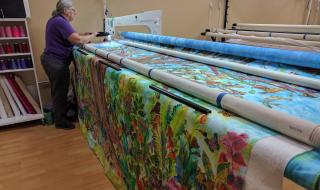Advertisement
‘Together We Grow” is an ambitious and aptly named collaborative quilting project created by members of Thomas Jefferson Unitarian Church in Louisville, Kentucky. The 8.5 x 9 foot applique quilt took sixty-three volunteers ages 5 to 85 two years to complete.
“The community pride felt by the whole church was so fulfilling,” says Lori Sargent, who helped orchestrate the complex project. “I’ve often seen someone take a friend up to the quilt, pointing out a piece they worked on. Alone, it would be so difficult to make an artwork of this size and complexity, but now many people can point to the quilt with pride and say, ‘I helped make it!’”
For “Together We Grow,” the group envisioned a tree symbolizing the congregation. The trunk represents the church, strongly supporting the community; the branches are the connections between committees, chalice groups, and the larger community; the birds are members, friends, and visitors; the plants represent both the grounds and woods around the church and the varied work that the congregation finds meaningful.

A detail of the finished quilt shows the variety of birds and some of the messages about what makes the church “priceless.” (© Lori G. Sargent)
People were invited to identify what is “priceless” about the congregation as part of the creative process, says the Rev. Elwood Sturtevant. Statements such as, “I am free to ask questions without anyone judging me” and “What we learn reinvigorates our community” are embroidered on “bark” strips and incorporated in the branches and trunk.
The birds and the plants are a delightful mixture of realistic and stylized, in part because people of all ages and skill levels collaborated to create them. Birds designed by professional artists sit beside ones created by children, and yet—like a congregation itself—the variety only enriches the whole.
The quilt was designed between 2016 and 2017 under the supervision of members Pat Sturtzel, a quilt artist who taught each of the eighteen techniques used to make the quilt, and Sargent, a visual artist who was responsible for publicizing the project and encouraging people to participate.

Steve Reeves and Neisja Yenawine place birds on the quilt. (© Lori G. Sargent)
“A challenging part was to figure out how to keep people involved in small steps of the process—keeping people enthusiastic about what we were doing during the long process,” says Sargent. She says they continually presented steps that non-artists could complete successfully in a few minutes following a quick demonstration.
“The first year we held several evening workshops for adults and Sunday workshops for children and youth where we dyed all the fabric and began designing bird stamps,” Sargent says. The second year they set up tables about once a month during coffee hour and invited everyone to print birds and plants. Then they handed out instructions and materials for embroidering quotes and plants and cutting out bird and plant pieces so participants could continue the work at home. After all of the various parts were finished and assembled—293 birds, 14 insects, 97 quotes about the congregation, and a couple hundred plants—six people constructed a composition based on a 6-inch sketch. It took Sturtzel and Sargent twelve hours to quilt the work, and additional volunteers added the binding and helped hang the completed piece.
“Be flexible with the amount of time it takes,” Sargent advises other congregations contemplating such a project, “and provide opportunities for people of many abilities to contribute. I thought our quilt would take a few months—and two years later it was ‘suddenly and delightfully’ finished.”
The quilt is now displayed in the congregation’s sanctuary, where Sturtevant says “it adds color, warmth, and a sense of welcome and invitation.” It was also part of the “Storied Threads” quilt exhibit at the Behringer-Crawford Museum in Covington, Kentucky, from February through May 2018.
“I think the process was as important as the finished product,” says Sargent. “It means something different to each of us, and that’s okay. That we ended up with something that people wanted in the sanctuary was an unexpected, rewarding result.”
Though they haven’t yet announced another collaborative project, she says there are already inquiries—and plenty of people ready to work together to create it.
